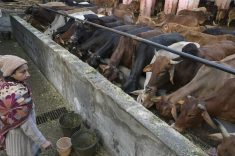We had more market news than these pages will accommodate this week so I recommend turning to page 71 for an informative guest column on barley market developments by Brenda Tjaden Lepp of FarmLink Marketing Solutions.
Market watchers are wondering how wide the corn-wheat price spread can get as production outlooks for the two grains diverge.
Weather in the U.S. Midwest has become almost ideal in recent weeks, with good moisture in most areas during the critical corn pollinating period. Worries about producing a crop adequate to meet the needs of ethanol producers, livestock feeders and the export market have receded with the improving prospect of a record large crop. Soybean conditions have also improved, pressuring the oilseed’s price lower.
Read Also

Canada-U.S. trade relationship called complex
Trade issues existed long before U.S. president Donald Trump and his on-again, off-again tariffs came along, said panelists at a policy summit last month.
But wheat production prospects continue to decline around the world. Last week this pushed the spread between corn and wheat to a 30 year high. Normally, the spread between the two grains is kept in check because they are partly interchangable in the feed market. If wheat gets too expensive, it prices itself out of the feed market and if corn prices rise, more wheat is consumed by livestock. But that rule is being stretched as price-supporting wheat news piles up.
The heat wave enveloping the Canadian Prairies and U.S. Northern Plains will likely trim yields, analysts still expect a good crop because of favourable weather in most areas until now.
Farther south, analysts are talking about significant areas of U.S. winter wheat that will not be cut.
Many fields yielded poorly in northeastern Oklahoma and southeastern Kansas, where it rained almost nonstop in the second half of June, and much of the harvested wheat was sprouted and had light test weights.
“Wheat in those areas is looking like pretty much zero yield. In the areas which were not rained on as severely, you’re looking at substantial quality losses but they still managed to get some yield,” Kansas State research and extension agricultural economist Art Barnaby told Reuters.
Damage from an April frost was also more severe than thought, said Mike Woolverton, grain marketing economist at Kansas State University.
“I think there’s going to be a lot of plumes of black smoke across the southern Great Plains over the next few weeks,” as farmers use controlled burns to clear unharvested fields, Woolverton said.
In Europe, wheat prices rose early this week on heavy rain in Britain and disappointing results from early harvest in France.
“The harvest is going to be late and quality is going to be an issue,” one French trader told Reuters.
Traders said early harvest indications from south-central France showed yields significantly below the average, with some putting them at 15 to 22 bushels per acre below normal.
Meanwhile, Ukraine confirmed it will harvest a smaller crop this year. It said it was likely to harvest 11.7 million to 12.6 million tonnes of wheat and about seven million tonnes of barley. It harvested 13.9 million tonnes of wheat and 11.3 million tonnes of barley in 2006.
Australian forecasters are stepping back from early predictions of a near record crop and now talk of an average crop because of lingering dry conditions, especially in the west.
Argentina’s grain exchange said July 20 that if current dry weather persists, the forecast for seeded wheat area might be reduced.
Demand news has also been good. Morocco is buying to make up for a drought-damaged crop. Other North African countries have also been active buyers and Iraq and India are expected to be in the market.














